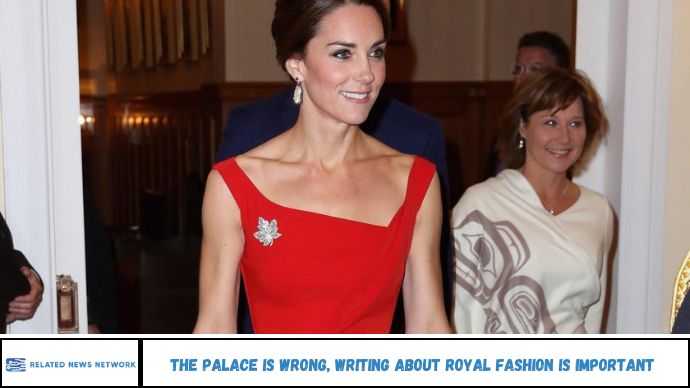Royal Fashion Coverage Matters: Why The Palace Is Wrong
The Palace is wrong, writing about royal fashion is important Is royal fashion frivolous? Not according to history, public influence, or billions in economic impact. Yet, recent statements from Palace insiders downplaying the significance of fashion coverage have sparked debate. Many suggest fashion commentary distracts from “more serious” royal duties.
But here’s the truth: writing about royal fashion is not only relevant, it’s essential. From shaping national identity to influencing global fashion industries and signaling political messages, royal style is far more than fabric and designers.
It’s understandable that the Princess of Wales might want to shift the media’s attention from her wardrobe to her work. After fourteen years in her role within “The Firm,” many of the charities she supports—around twenty in total—have become deeply personal causes. It must be disheartening to see a bracelet receive more coverage than a significant initiative launched by The Centre for Early Childhood, the institution she helped establish and passionately champions.
And given the challenges she’s faced this past year, it’s only natural that she’s gained new perspective—on both her public duties and how she wants to carry them forward. Priorities evolve, and so do approaches.
Still, the Palace’s recent decision to withhold details about her clothing—except for state and formal occasions—feels oddly short-sighted. At this point, when she is one of the most respected and admired public figures, why not acknowledge that her style is part of what draws attention to her work? The reality is that her fashion choices breathe life into otherwise overlooked engagements.
Seeing the Princess appear in a dazzling Jenny Packham gown is more than a moment of glamour—it offers a sense of national pride, joy, and connection at a time when many public figures disappoint. And truthfully, it’s that same visual appeal that has helped elevate awareness of causes like the Centre for Early Childhood to a much broader audience.
Abstract
Royal fashion is a powerful form of soft diplomacy, economic stimulation, and cultural storytelling. While critics argue it’s superficial, writing about royal style uncovers political nuance, public messaging, and economic ripple effects. Ignoring it misses a critical layer of monarchy influence and public identity.
1. Fashion Has Always Been a Royal Language
From Elizabeth I’s opulent gowns to Princess Diana’s revenge dress, fashion has always served as a non-verbal communication tool for royals. Every hemline and color choice has a purpose.
Key examples include:
- Queen Elizabeth II used color-blocked coats to ensure visibility during engagements.
- Princess Diana signaled independence with dramatic silhouettes post-divorce.
- Catherine, Princess of Wales, champions British designers to promote national identity.
Royal fashion sends signals—subtle and powerful—about values, transitions, and intent.
2. Royal Fashion Drives Economic Impact
Fashion worn by royals doesn’t just appear on front pages—it drives sales and sparks global trends.
- The “Kate Effect” has been documented to boost a brand’s sales by up to 500% within 24 hours.
- A report by Brand Finance UK estimates the British royal family contributes £1.8 billion annually to the UK economy, with fashion and merchandise being significant contributors.
Ignoring this influence disregards the real-world economic benefit of royal wardrobes.
3. Fashion Coverage Builds Cultural Relevance
Royal fashion creates shared cultural moments. People around the world remember what Meghan Markle wore on her wedding day or how Queen Elizabeth dressed for her Platinum Jubilee.
These style choices help define eras and create points of public engagement. Fashion is how the monarchy remains visually present in people’s lives.
When coverage is limited, it distances the public from these symbolic touchpoints.
4. Fashion Writing Can Be Feminist and Political
Royal women often navigate double standards in public scrutiny. Writing critically about their fashion choices can shed light on gender bias, expectations, and agency.
- Discussing Meghan Markle’s clothing opens up conversations about race, class, and media representation.
- Catherine’s consistent elegance highlights her understanding of duty through presentation.
- Queen Letizia of Spain uses fashion to bridge modernity and tradition.
Fashion writing can dissect power dynamics and reveal deeper narratives behind public appearances.
5. Style Coverage Keeps the Monarchy Modern
In a world of digital engagement and visual culture, fashion is one of the few tools the monarchy has to remain relatable. It generates social media attention, headlines, and public discourse—especially among younger generations.
Ignoring fashion reporting risks painting the monarchy as outdated or disconnected from contemporary life.
6. Journalism Isn’t Diminished by Covering Fashion
Writing about royal fashion is not shallow—it’s journalism with context. Well-written fashion coverage blends art, politics, history, and society. It deserves the same respect as other forms of analysis.
When done well, it informs, inspires, and investigates.
FAQs
1. Isn’t royal fashion coverage just superficial celebrity news?
No. It often uncovers political messages, cultural shifts, and historical symbolism embedded in clothing.
2. Do royal fashion articles really influence the public?
Yes. Coverage can drive massive economic impact and shape global fashion trends.
3. Is writing about fashion disrespectful to royal roles?
Not at all. Fashion is part of how royals communicate and fulfill their duties.
4. Can fashion writing be considered serious journalism?
Absolutely. It combines history, politics, and sociology with cultural commentary.
5. Why does the Palace discourage too much focus on fashion?
Often to control the narrative or avoid reducing royal work—but ignoring fashion ignores how they engage visually.
6. Who benefits most from royal fashion coverage?
The public, fashion industry, and royals themselves—all gain visibility, engagement, and influence.
Conclusion
Royal fashion is a strategic tool, not a side note. Writing about it provides insight into how monarchies evolve, communicate, and stay relevant. It empowers readers to understand not just what is worn—but why.
The Palace may wish to minimize fashion coverage, but doing so diminishes the cultural, political, and economic power behind every outfit. True journalism asks questions, explores meaning, and amplifies nuance—and royal fashion is full of it.









